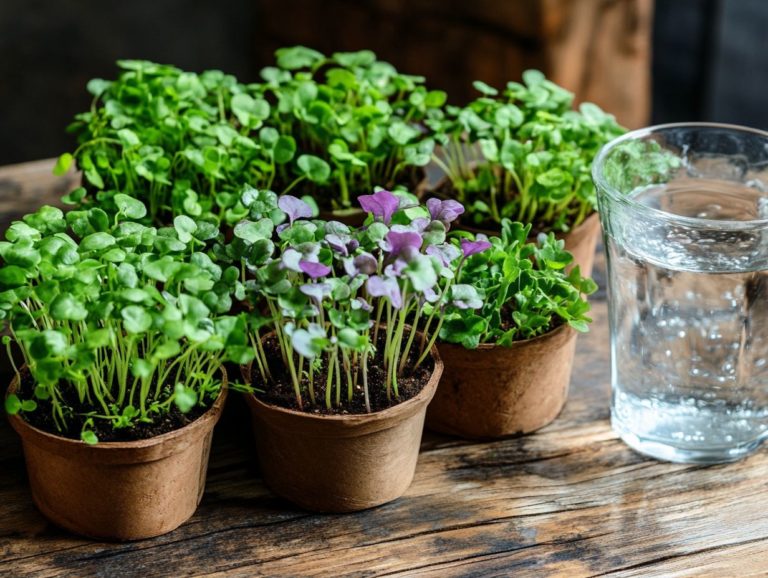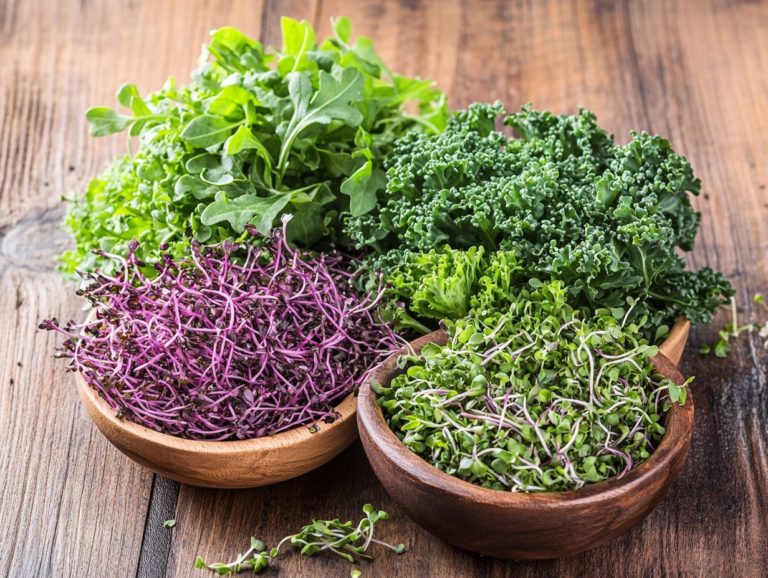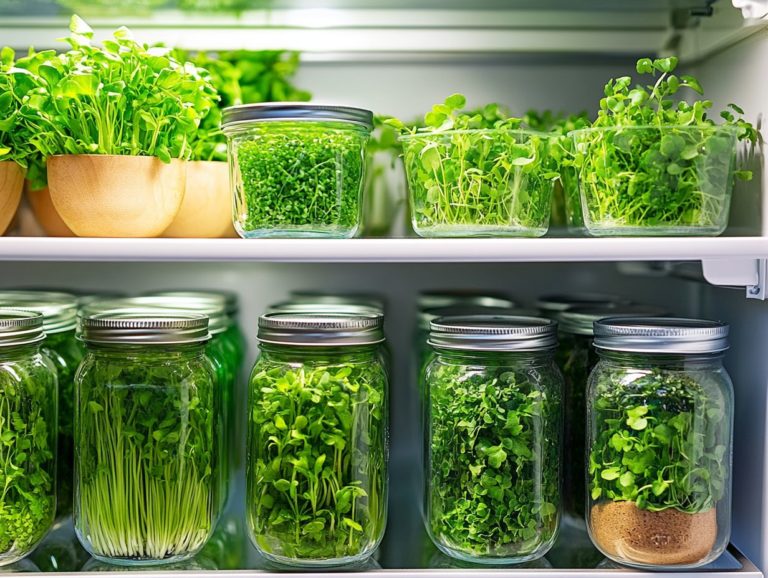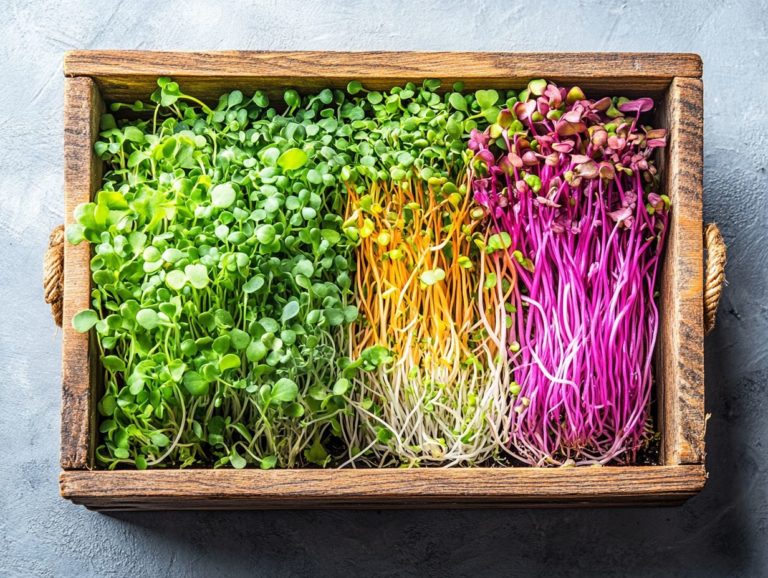Microgreens: The Secret to Healthy Skin
Microgreens are far more than mere trendy garnishes; they offer a remarkable nutritional boost that can profoundly enhance your skin health.
These tiny, nutrient-dense plants are brimming with antioxidants and anti-inflammatory properties, working to promote a radiant complexion and improve skin texture.
You ll explore the definition and nutritional profile of young vegetables like broccoli and kale. Discover how to seamlessly incorporate them into your meals with delightful recipes. Follow a step-by-step guide to growing your own.
We’ll make sure you know how to enjoy these greens safely while addressing potential risks, ensuring you reap the full benefits of these vibrant greens.
Start your journey toward healthier, glowing skin today!
Contents
- Key Takeaways:
- What are Microgreens?
- Benefits for Skin Health
- How to Incorporate Microgreens into Your Diet
- Growing Your Own Microgreens
- Potential Risks and Considerations
- Frequently Asked Questions
- Want glowing skin? Here s how microgreens can help!
- How do microgreens compare to other superfoods for skin health?
- Which types of microgreens are best for skin health?
- How can I incorporate microgreens into my daily routine for better skin?
- Are microgreens safe for everyone, including those with allergies?
- Is there a recommended daily amount of microgreens to consume for skin health?
Key Takeaways:
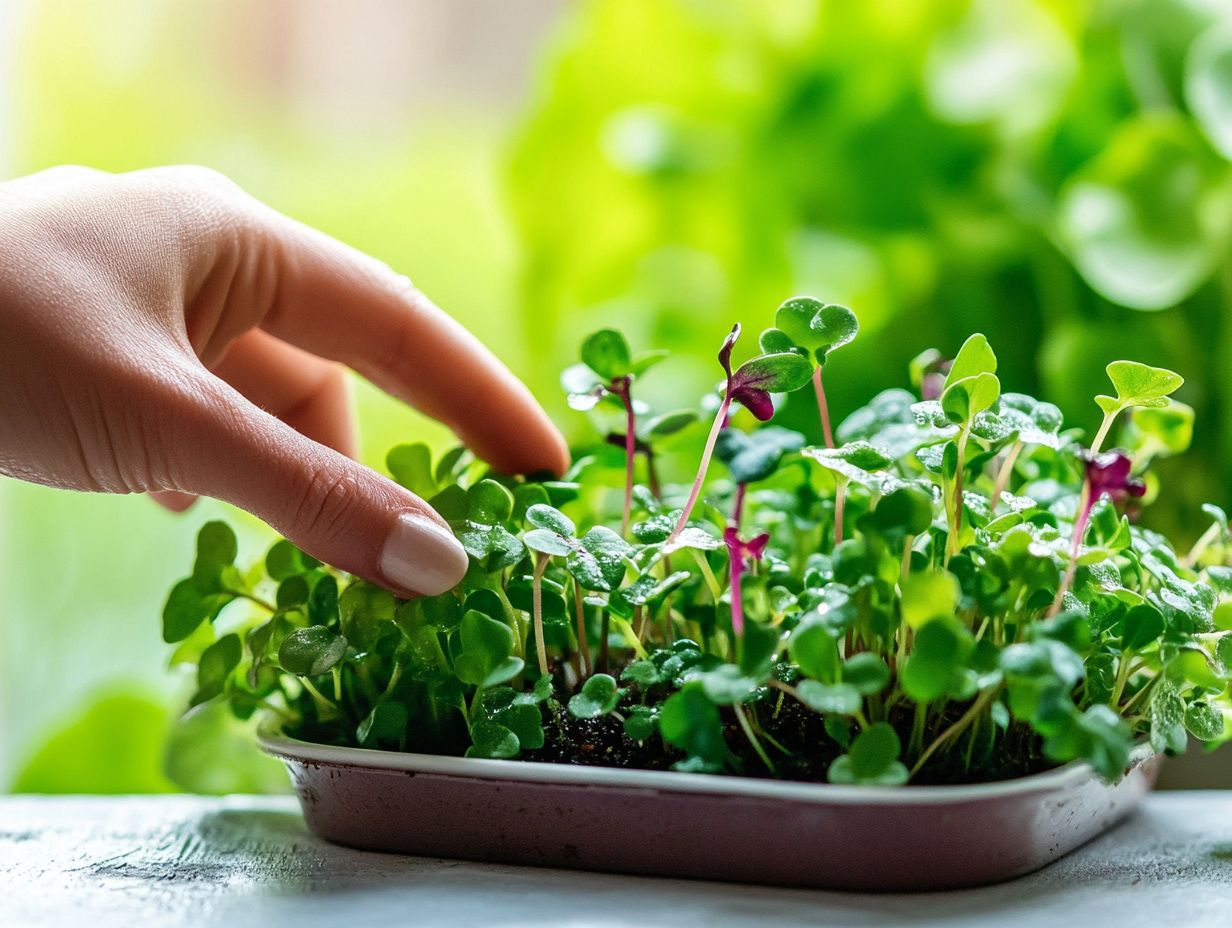
What are Microgreens?
Microgreens are young vegetables harvested at an early stage, typically within 7 to 14 days of germination. They belong to a family of vegetables that includes broccoli and kale.
These petite greens are not just a feast for the eyes; they are brimming with essential vitamins and minerals. They provide a range of flavors that can elevate any dish you create.
With culinary experts and health aficionados alike singing their praises, microgreens have skyrocketed in popularity. Their remarkable nutritional benefits and effortless integration into various diets make them a popular choice for health-conscious eaters.
Definition and Nutritional Profile
The nutritional profile of microgreens is nothing short of remarkable. They often boast higher concentrations of vitamins and antioxidants than their fully grown counterparts.
These petite greens are particularly abundant in vitamins A, C, and E, all essential for maintaining a strong immune system and promoting healthy skin. Add to that the presence of polyphenols, compounds celebrated for their anti-inflammatory properties. Incorporating microgreens into your diet can be a great choice, as why microgreens are essential for a balanced diet.
Microgreens can contain up to 40 times the level of key nutrients compared to mature vegetables. This suggests that incorporating them into your diet could significantly enhance your overall well-being. For those managing diabetes, the high antioxidant content may assist in regulating blood sugar levels. Meanwhile, the vitamins work to support skin health, helping you achieve a radiant complexion. To learn more about how these tiny greens can impact your health, check out the science behind microgreens and health.
Benefits for Skin Health
The benefits of microgreens transcend mere nutrition; they have a profound effect on skin health as well. Their abundant antioxidants and polyphenols work diligently to combat various skin conditions, ultimately promoting a radiant and youthful complexion.
Embracing microgreens in your diet can elevate not just your meals, but also your skin’s vitality.
Antioxidant and Anti-inflammatory Properties
Microgreens are hailed for their remarkable antioxidant and anti-inflammatory properties, essential for maintaining skin health and staving off premature aging.
Packed with vital compounds like polyphenols, flavonoids, and vitamins C and E, these tiny greens act as a formidable defense against the harmful effects from free radicals. For example, the polyphenols in broccoli and radish microgreens work to neutralize harmful free radicals, curbing inflammation and promoting collagen synthesis.
Research from the Cleveland Clinic underscores how adding these microgreens to your diet can improve skin elasticity and diminish signs of aging.
Experts agree that regularly indulging in these nutrient-dense greens not only nourishes your skin from within but also elevates its overall appearance, making them a worthy addition to your daily skin care routine.
Improved Skin Appearance and Texture
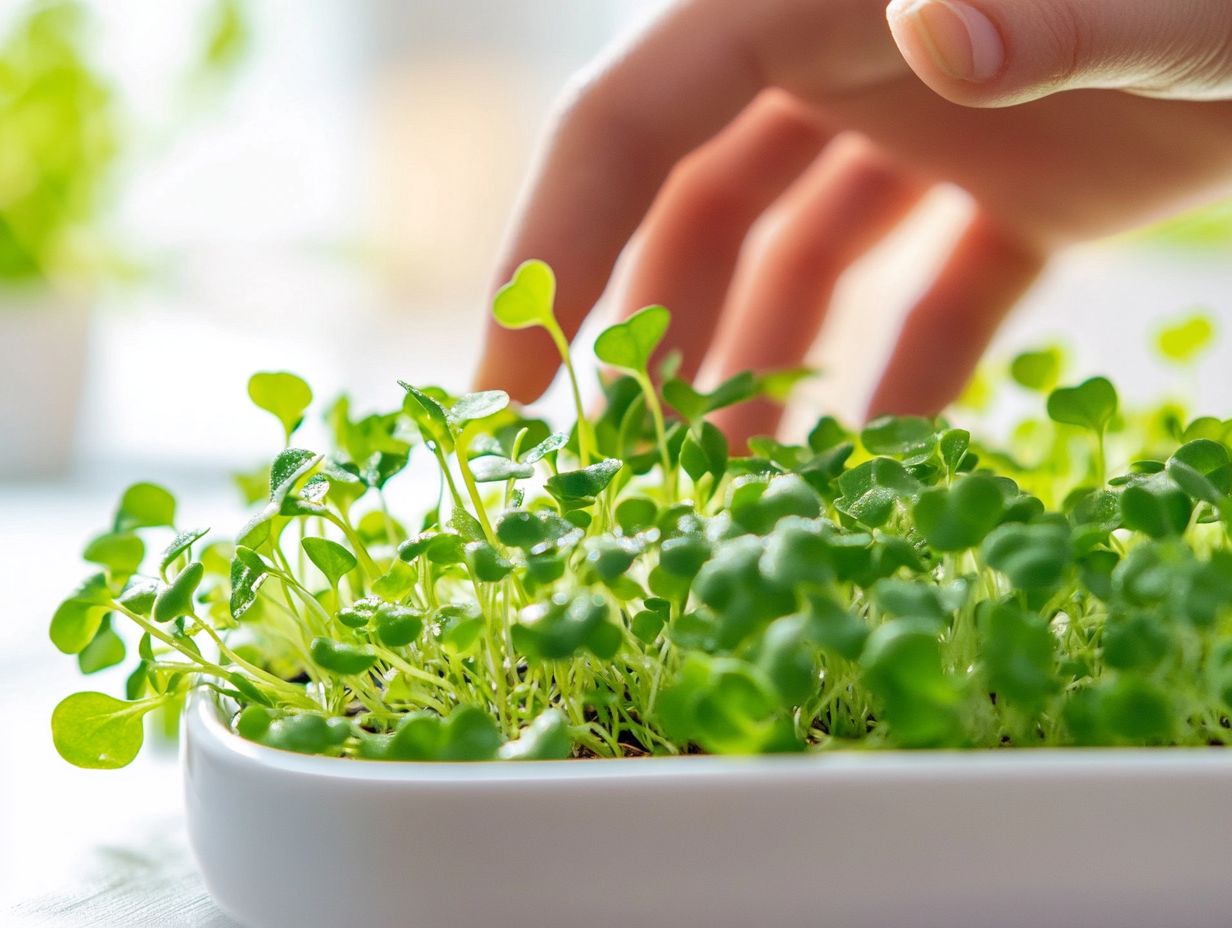
Incorporating microgreens into your diet can genuinely elevate the appearance and texture of your skin, thanks to their impressive concentration of vitamins and minerals that nourish it.
These petite powerhouses are often brimming with essential nutrients like Vitamin C and Vitamin E, both of which play important roles in promoting skin health. Vitamin C is renowned for its role in collagen production, a crucial protein that maintains your skin’s elasticity and firmness, while Vitamin E effectively shields your skin from harmful UV rays and environmental damage. To further enhance your diet, consider how you can supercharge your meals with microgreens.
Experts have observed that regular consumption of microgreens can alleviate various skin conditions, providing a natural way to care for your skin. You can easily add microgreens to salads, smoothies, or use them as a garnish. To learn more about their benefits, check out why microgreens are superfoods you need. They blend seamlessly into your daily meals.
Some people have found success using microgreen-infused oils or serums, including fenugreek and radish, enhancing their skincare routines and maximizing the rejuvenating effects for their skin. For more insights, check out unlocking the antioxidant power of microgreens.
How to Incorporate Microgreens into Your Diet
Adding microgreens to your meals is effortless and elevates both the flavor and nutrition of your dishes, seamlessly aligning with contemporary food trends that prioritize health and wellness while providing supplement benefits.
Recipes and Meal Ideas
Discover a collection of delicious and nutritious recipes that incorporate microgreens, offering you creative meal ideas that enhance both flavor and health benefits.
Imagine delicious salads loaded with fresh greens and zesty dressings, or energizing smoothies perfect for a quick breakfast; each dish showcases the remarkable versatility of microgreens. For instance, you can whip up a simple microgreens salad and customize it with your favorite vegetables, drizzled with a tangy vinaigrette that delivers a powerhouse of vitamins and antioxidants. Discover more about the impact of microgreens on overall wellbeing.
You can blend a nutrient-packed smoothie with microgreens like kale or radish sprouts, and tailor it to your taste by adding fruits such as bananas or berries for a touch of sweetness. Microgreens also make for a striking garnish on entrees, infusing a pop of color and a punch of flavor, making them ideal for both vegetarian and meat-based dishes. Exploring the health benefits of growing your own microgreens can further enhance your culinary experience.
Each of these recipes can effortlessly adapt to various dietary needs whether gluten-free, vegan, or low-carb ensuring that everyone at your table is enticed by the meal while benefiting from iron and vitamins.
Growing Your Own Microgreens
Growing your own microgreens is an exciting adventure! It offers you the luxury of fresh, nutrient-dense greens right from the comfort of your home.
It s surprisingly straightforward when you follow a simple step-by-step guide to growing microgreens from the cabbage family.
Step-by-Step Guide
Follow this step-by-step guide to grow your own microgreens like broccoli and kale at home and enjoy the rich nutritional benefits they provide.
- Start by selecting high-quality seeds; opt for vibrant varieties like basil, radish, or kale that promise a bounty of flavor and nutrients.
- Preparing a suitable growing medium be it potting soil or coconut coir is key to giving your young plants the support they need to thrive.
- Pay close attention to optimal growing conditions: aim for about 12-16 hours of light each day and maintain a cozy temperature around 70 F.
- Establishing a consistent watering schedule is essential; keep the soil moist but not soggy to prevent the unwelcome guest known as mold.
- Regularly inspect for pests like aphids or fungus gnats. This proactive approach not only safeguards your young greens but also makes microgreen cultivation a straightforward and highly rewarding endeavor.
Potential Risks and Considerations
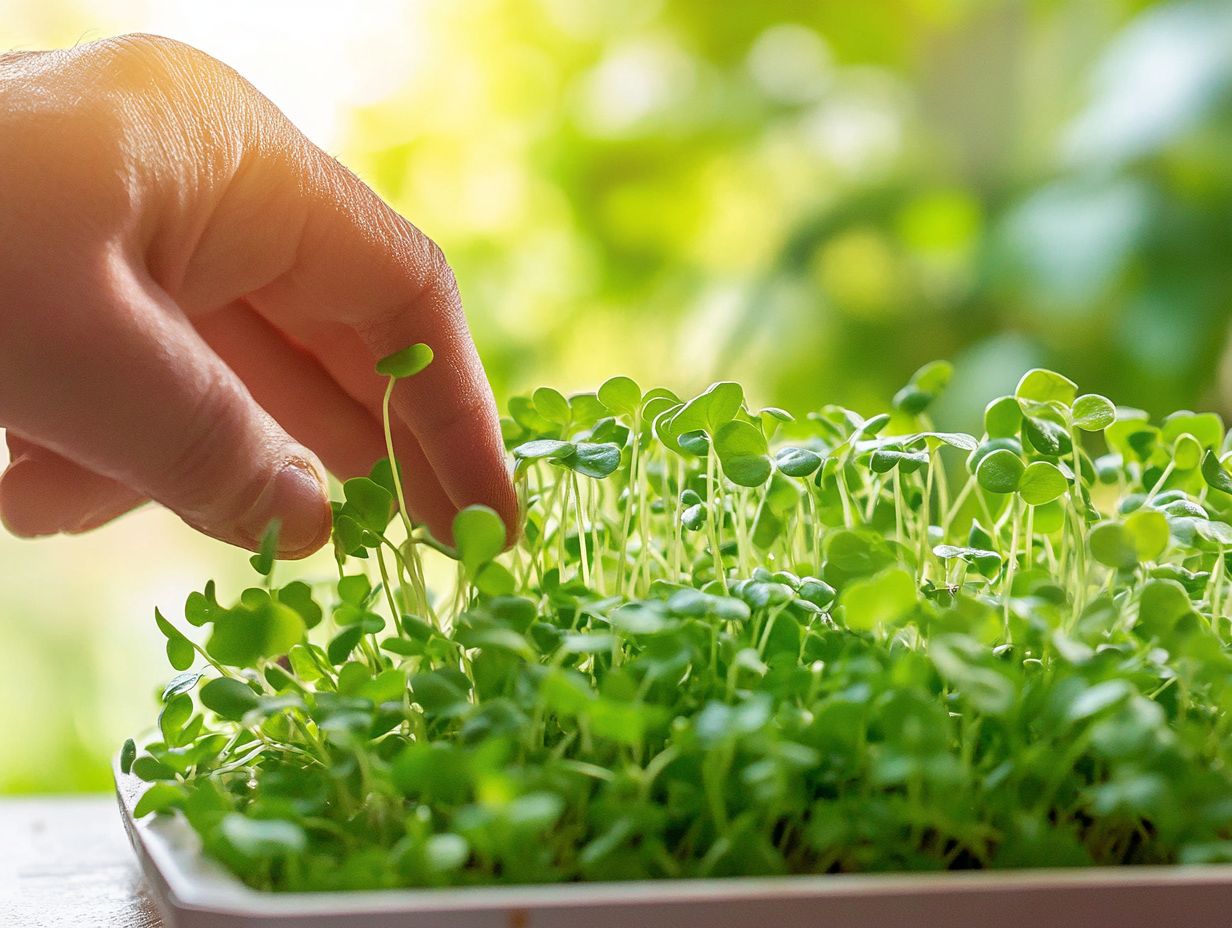
While microgreens provide a wealth of health benefits, be aware of potential risks, like allergies or contamination from microgreens.
Allergies and Contamination
Allergies to certain microgreens can indeed happen, making it essential for you to be aware of contamination risks for safe consumption.
Research has shown that microgreens such as arugula and basil might trigger allergic reactions in sensitive individuals. This emphasizes the importance of recognizing potential hazards. By ensuring these nutrient-packed sprouts are properly washed, you can significantly reduce the presence of pesticide residues and harmful pathogens. For more on the benefits of these greens, check out microgreens: tiny greens, big benefits.
A study published in the Journal of Food Protection revealed that thorough rinsing could cut bacterial load by as much as 90%.
Sourcing these delicate greens from certified growers who follow strict safety protocols can greatly minimize allergy risks and empower you to embrace safer eating habits.
The Power of Microgreens for Healthy Skin
The power of microgreens extends to promoting healthy skin. Their rich antioxidants and polyphenols can significantly enhance your skin’s texture and vitality.
These tiny greens, like radish and sunflower microgreens, are not just brimming with vitamins and minerals. They also boast high levels of flavonoids and carotenoids that actively combat free radicals, harmful molecules that can damage cells, reducing oxidative stress and warding off premature aging. Additionally, understanding the role of microgreens in healthy eating can further enhance your diet.
If you’re looking to revitalize your skincare routine, don’t wait—consider incorporating these vibrant greens into your salads, smoothies, or as a garnish on your dishes. You can also extract their nutrients for use in skincare products for impressive results, making these greens a versatile ally in your quest for youthful, radiant skin. Discover the benefits of eating microgreens daily to enhance your health even further.
Frequently Asked Questions
Want glowing skin? Here s how microgreens can help!
Microgreens are young vegetable greens packed with nutrients and antioxidants. They offer a concentrated dose of vitamins and minerals that promote healthy skin by improving collagen production, reducing inflammation, and protecting against UV damage.
How do microgreens compare to other superfoods for skin health?
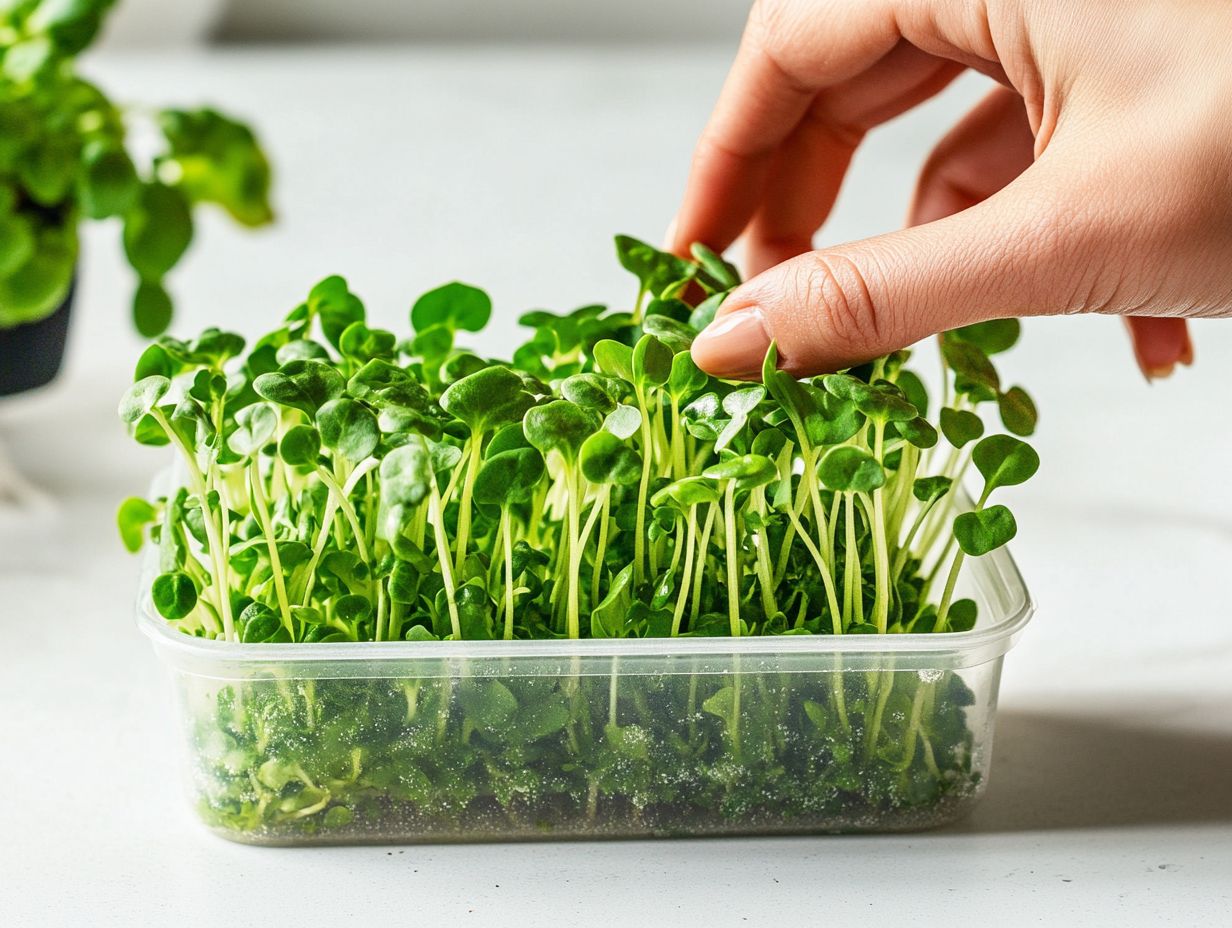
These greens are among the most nutrient-rich foods, containing up to 40 times more nutrients than their mature counterparts. This makes them a powerful addition to any diet for promoting healthy skin.
Which types of microgreens are best for skin health?
While all microgreens offer benefits for skin health, some varieties have higher levels of skin-loving nutrients. Top picks include broccoli, kale, arugula, and radish microgreens.
How can I incorporate microgreens into my daily routine for better skin?
These greens are incredibly versatile. You can add them to salads, smoothies, sandwiches, or use them as a garnish. Try incorporating a handful into your meals each day for a boost of skin-healthy nutrients.
Are microgreens safe for everyone, including those with allergies?
In general, microgreens are considered safe for most people. However, if you have allergies to certain types of greens, it s best to consult with your doctor before consuming them. Properly washing and cleaning microgreens before consumption is crucial to avoid any potential contamination.
Is there a recommended daily amount of microgreens to consume for skin health?
While there is no specific recommended daily amount, incorporating a variety of microgreens into your diet each day can provide a significant boost of skin-nourishing nutrients. Start with a small amount and gradually increase as desired.


